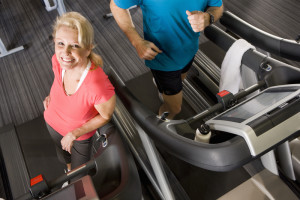Benefits of Exercise: Good Medicine for the Body and Mind
Getting started might be the hardest part, but once you get into a fitness routine, you’ll find that the benefits of exercise help in multiple areas of your life.
Exercise confers many health advantages. It can help counteract blood vessel diseases that play a role in our cardiovascular health, preserve cognitive function as we age, and help protect us from cancer.
Get Motivated to Get the Benefits of Exercise
We’ve long understood the benefits of exercise. It unlocks the door to better physical function and elevated self-esteem. All you need is the desire, a little time, and a quick check with your physician to make sure your exercise activities are compatible with your current health status and possible physical limitations, especially if you haven’t been physically active for a while.
If the latter applies to you, start low and go slow—maybe five minutes a day, three times weekly. Then increase the time you spend exercising as your body tolerates more. Eventually your regimen should incorporate elements of endurance, strength, flexibility, and balance.
No Equipment Needed
Keep in mind that exercise doesn’t necessarily require fancy equipment. Walking is a case in point—all you need is a pair of supportive walking shoes and an inexpensive pedometer if you want to keep track of how many steps you take. Got a smartphone? Then download a free pedometer app from its linked app store. Aim to walk for 30 minutes every day, but remember that you don’t have to accomplish this all at once. You could walk three times a day for 10 minutes, and still derive benefits.

Treadmill, walking, hiking, swimming, tennis, yoga—there are countless ways to enjoy the benefits of exercise. Key: Finding a routine and sticking to it. [Photo: © Flair Images | Dreamstime.com]
Who among us wouldn’t want increased energy and stamina, less body fat, and stronger bones? You can reap these benefits—along with better sleep, improvements in mood and memory, and a reduction in stress—simply and inexpensively with a prescription called exercise.
If you don’t have any dumb-bells, you can perform lifts with a can of soup in each hand—and even carrying laundry or groceries also provides benefit if you do it regularly. For your legs, invest in light ankle weights or inexpensive exercise bands.
Exercise for Arthritis or Osteoporosis Sufferers
Even if you have physical limitations such as arthritis or osteoporosis, there are exercises you can do. Simple stretching exercises can decrease joint pain from osteoarthritis, while strength training helps maintain bone mass. Cardio exercises performed in a pool work well for people with arthritis and osteoporosis because water supports body weight, relieving the burden on joints.

Done regularly (two to three times a week), strength-training exercises “build muscle strength and muscle mass and preserve bone density, independence, and vitality with age,” according to the National Institutes of Health. [Photo: © Brainsil | Dreamstime.com]
Think about strength training too. For your arms, dumb-bells will work—and they don’t have to be heavy. Light weights combined with more reps (the number of times you perform an exercise) provide the same muscle-building benefits as heavier weights and fewer reps.
Don’t fall into the trap of thinking that age poses any kind of barrier when it comes to exercise. There are no absolute contraindications for exercise based on age, although any activity should take into consideration your health and current functioning.
There is one proviso, however: If you have chest pain or new shortness of breath, exercise should be discontinued immediately until you get an evaluation by your physician.
Rosanne Leipzig, MD, PhD, is Professor and Vice Chair of the Brookdale Department of Geriatrics and Adult Development at the Icahn School of Medicine at Mt. Sinai in New York, N.Y. She also serves as Editor-in-Chief of the monthly publication Mount Sinai School of Medicine Focus on Healthy Aging. Visit her website at rosannemd.com.
Originally published in 2017 and regularly updated.


 Keep Walking to Lower Your Depression Risk
Keep Walking to Lower Your Depression Risk  Exercises For Mobility
Exercises For Mobility  Living with Dementia Means Having a Greater Fall Risk
Living with Dementia Means Having a Greater Fall Risk 
Rosanne Leipzig, MD, PhD, is Professor and Vice Chair of the Brookdale Department of Geriatrics and Adult Development at the Icahn School of Medicine at Mt. Sinai in New York, N.Y. She also serves as Editor-in-Chief of the monthly publication Mount Sinai School of Medicine Focus on Healthy Aging.